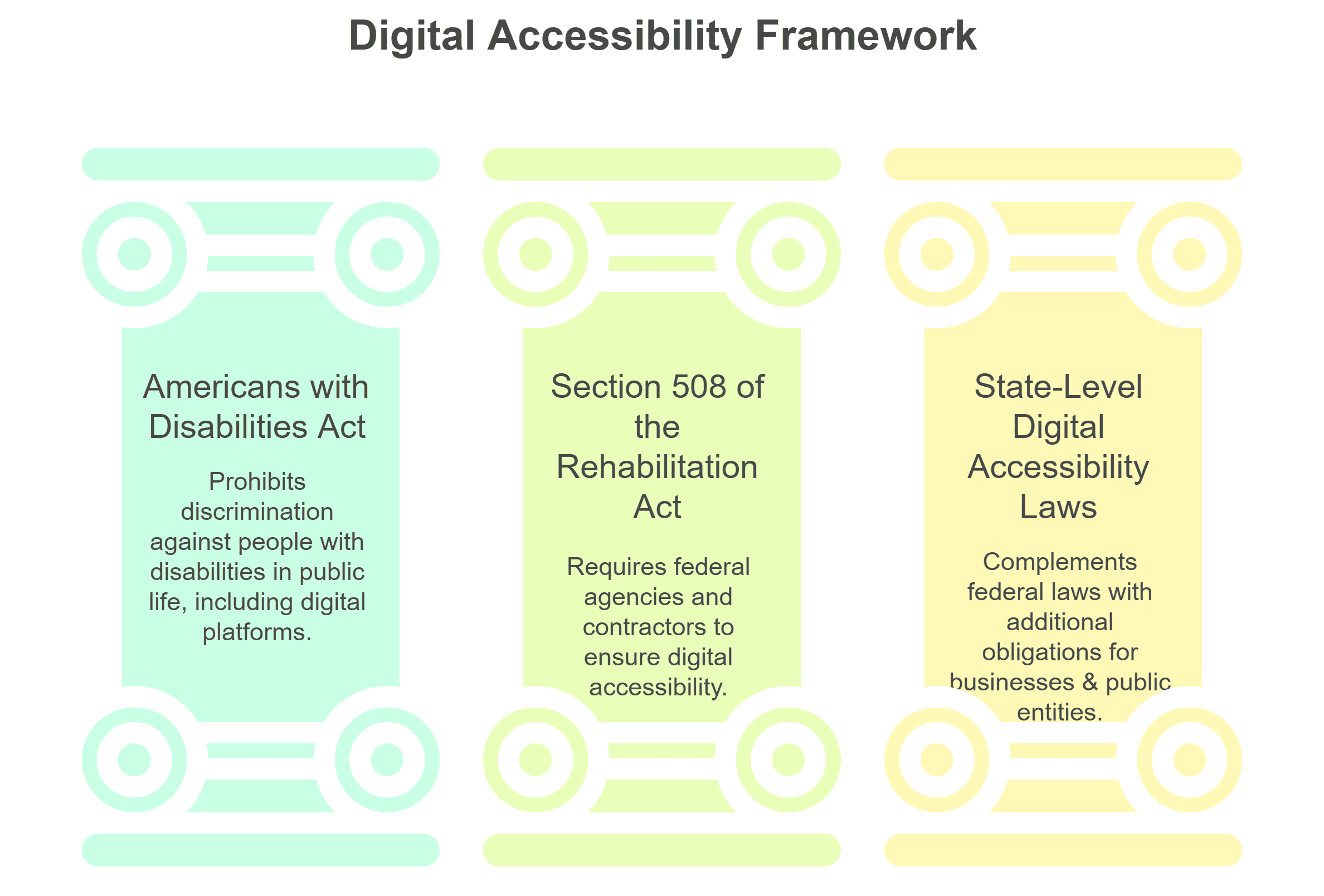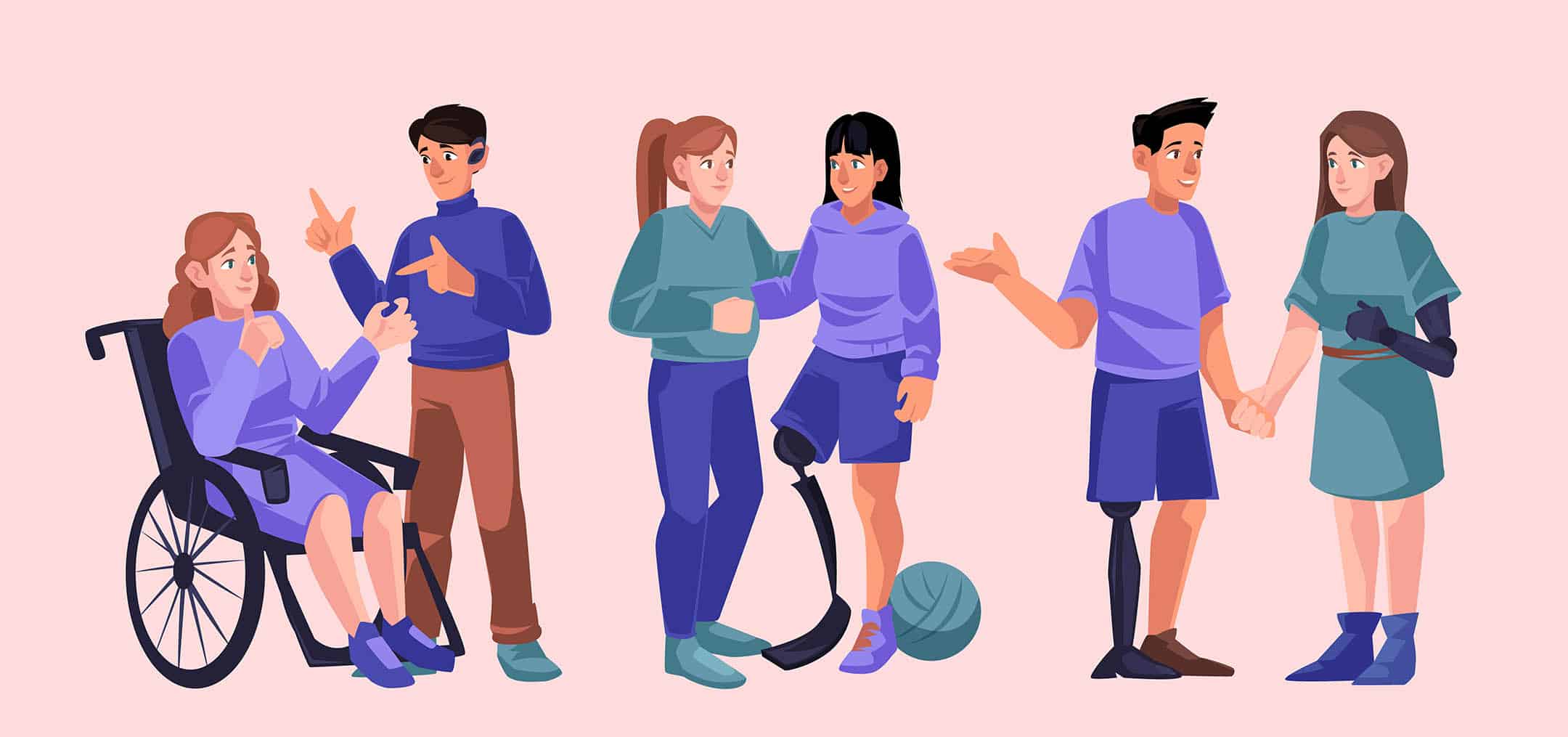In the US, digital accessibility laws and compliance standards ensure that online content and services accommodate people with disabilities. These laws help remove barriers that prevent equal access to digital content and services. While some laws are mandatory and enforceable by government agencies and courts, guidelines like the Web Content Accessibility Guidelines (WCAG) provide the technical framework organizations use to meet compliance requirements. Together, these laws and standards promote inclusion and equal opportunity in the digital world.
Mandatory Digital Accessibility Laws in the US
Digital accessibility and inclusive web design are no longer optional for organisations operating in the United States. As the digital world has become central to daily life, federal laws now require that websites, mobile apps, and online services be accessible to everyone, including people with disabilities. These regulations aim to remove digital barriers, ensuring equal access to information, products, and services. Understanding these legal obligations is essential for any business or institution seeking to comply with accessibility standards and avoid potential lawsuits.

Loven om amerikanere med nedsatt funksjonsevne (ADA)
Den Lov om amerikanske borgere med nedsatt funksjonsevne (ADA) is a landmark civil rights law passed in 1990 that prohibits discrimination against individuals with disabilities in all areas of public life. It applies nationwide to businesses, state, and local governments. Title III of the ADA extends obligations to digital platforms and websites, recognizing that online services are places of public accommodation.
Under the ADA, all businesses and public entities must provide “reasonable accommodations” in their digital services to ensure equal access for people with disabilities. This includes making websites and applications accessible to users with visual, auditory, motor, or cognitive impairments. Enforcement of ADA compliance is carried out by the Department of Justice (DOJ) and federal courts, which have increasingly ruled that inaccessible websites violate the law.

Despite clear legal requirements under the Americans with Disabilities Act (ADA), the majority of businesses in the United States still fail to meet digital accessibility standards. Recent studies reveal that over 95% of websites have accessibility issues that would prevent users with disabilities from fully engaging with their content or services. These barriers range from missing text alternatives for images to poor colour contrast and inaccessible navigation. Such widespread non-compliance highlights a significant gap between legal obligations and actual practice, leaving many organisations vulnerable to lawsuits and, more importantly, excluding millions of users from equal digital access. Source: https://webaim.org/projects/million/
Paragraf 508 i rehabiliteringsloven
Seksjon 508 is a federal law that requires electronic and information technology (ICT) developed, procured, maintained, or used by federal agencies to be accessible to people with disabilities. It applies not only to federal agencies but also to contractors and vendors providing digital products or services to the government.
Section 508 mandates that websites, software, and ICT tools meet accessibility standards aligned with WCAG 2.0 and 2.1 Level AA, supporting broader digital accessibility compliance across federal services. Federal agencies are required to conduct regular compliance audits to ensure their digital content remains accessible. This law promotes transparency and equal access to government information and services.
Despite being a long-standing federal requirement, compliance with Section 508 remains inconsistent across US government agencies. Recent federal assessments show that only about 22% of top public webpages and 25% of intranet pages fully meet accessibility standards aligned with WCAG 2.1 Level AA. Nearly half of federal agencies also reported lacking formal accessibility programmes or policies to ensure compliance. These figures highlight the ongoing challenge of achieving true digital inclusivity within government systems, even under mandatory law.
(Sources: Section508.gov 2024 Assessment, GAO Report 2024)
State-Level Digital Accessibility Laws
Many US states have enacted their own digital tilgjengelighet laws or regulations that complement federal requirements. These state laws often impose additional obligations on businesses and public entities operating within their jurisdictions.
California’s Unruh Civil Rights Act, for example, includes provisions that extend to digital accessibility, requiring businesses to ensure their websites and online services are accessible. In New York, courts actively enforce website compliance under state law, holding organizations accountable for inaccessible digital content.
Additionally, some states require organizations to publish accessibility statements on their websites, outlining their commitment to accessibility and providing contact information for users who encounter barriers.
Digital Accessibility Guidelines and Standards
To achieve full digital accessibility compliance, organizations must follow recognized standards that define how online content should be designed and maintained for all users. These guidelines provide the technical foundation for inclusive web design, helping businesses and public bodies meet legal requirements under the ADA and Section 508. By adhering to established accessibility frameworks such as WCAG, organizations can create digital experiences that are both legally compliant and user-friendly for people with diverse abilities.
Retningslinjer for tilgjengelighet til webinnhold (WCAG)
Den Retningslinjer for tilgjengelighet til webinnhold (WCAG) are internationally recognized guidelines developed by the World Wide Web Consortium (W3C) to provide a clear framework for making digital content accessible. Although WCAG itself is not a law, it serves as the global benchmark for digital accessibility.
WCAG defines technical standards covering areas such as providing text alternatives for non-text content, ensuring keyboard navigation, maintaining sufficient color contrast, and creating understandable content. These guidelines are referenced in ADA and Section 508 enforcement actions, and courts frequently require organizations to meet WCAG standards as part of legal settlements.
ISO and Industry Standards
ISO 30071-1 is an international standard offering governance and strategic guidance for digital accessibility. It helps organizations integrate accessibility into their overall digital strategy and operations.
This standard is widely adopted by sectors such as technology, higher education, and healthcare. Following ISO 30071-1 demonstrates good practice and helps organizations reduce legal risks by embedding accessibility into their governance frameworks.
Voluntary Best Practices
Beyond mandatory compliance, many businesses adopt voluntary best practices to enhance digital accessibility. These include captioning video content, conducting testing with assistive technologies, and providing accessible customer support channels.
Implementing such measures not only fosters greater inclusivity but also improves search engine optimization (SEO) and strengthens brand reputation. Organizations that go beyond compliance signal a genuine commitment to accessibility and user experience.
Several US organizations have set strong examples by voluntarily adopting advanced digital accessibility practices that go beyond ADA and Section 508 compliance. Companies such as Capital One og Microsoft have developed comprehensive accessibility statements, implemented continuous testing with assistive technologies, and prioritized inclusive design in all digital products. Federal platforms like Section508.gov also demonstrate leadership by maintaining transparent accessibility policies and ensuring their content meets or exceeds WCAG 2.1 standards. Even private firms such as IBM, which has a long-standing commitment to accessibility, showcase how features like video captions, high colour contrast and clear keyboard navigation can enhance usability for everyone. These examples highlight how proactive accessibility fulfils ethical and legal duties while also strengthening brand trust and user engagement.
Embracing a Comprehensive Framework for Digital Accessibility
In the US, digital accessibility is shaped primarily by the ADA and Section 508, with additional reinforcement from state-level laws. These legal requirements establish a foundation for equal access to digital services and content. The Web Content Accessibility Guidelines (WCAG) provide the technical standards that organizations follow to meet these legal obligations effectively.
Together, these laws and standards create a comprehensive framework that ensures digital services are accessible to all users, regardless of their ability. Staying informed about evolving regulations and adopting best practices helps organizations maintain compliance and foster an inclusive digital environment.
